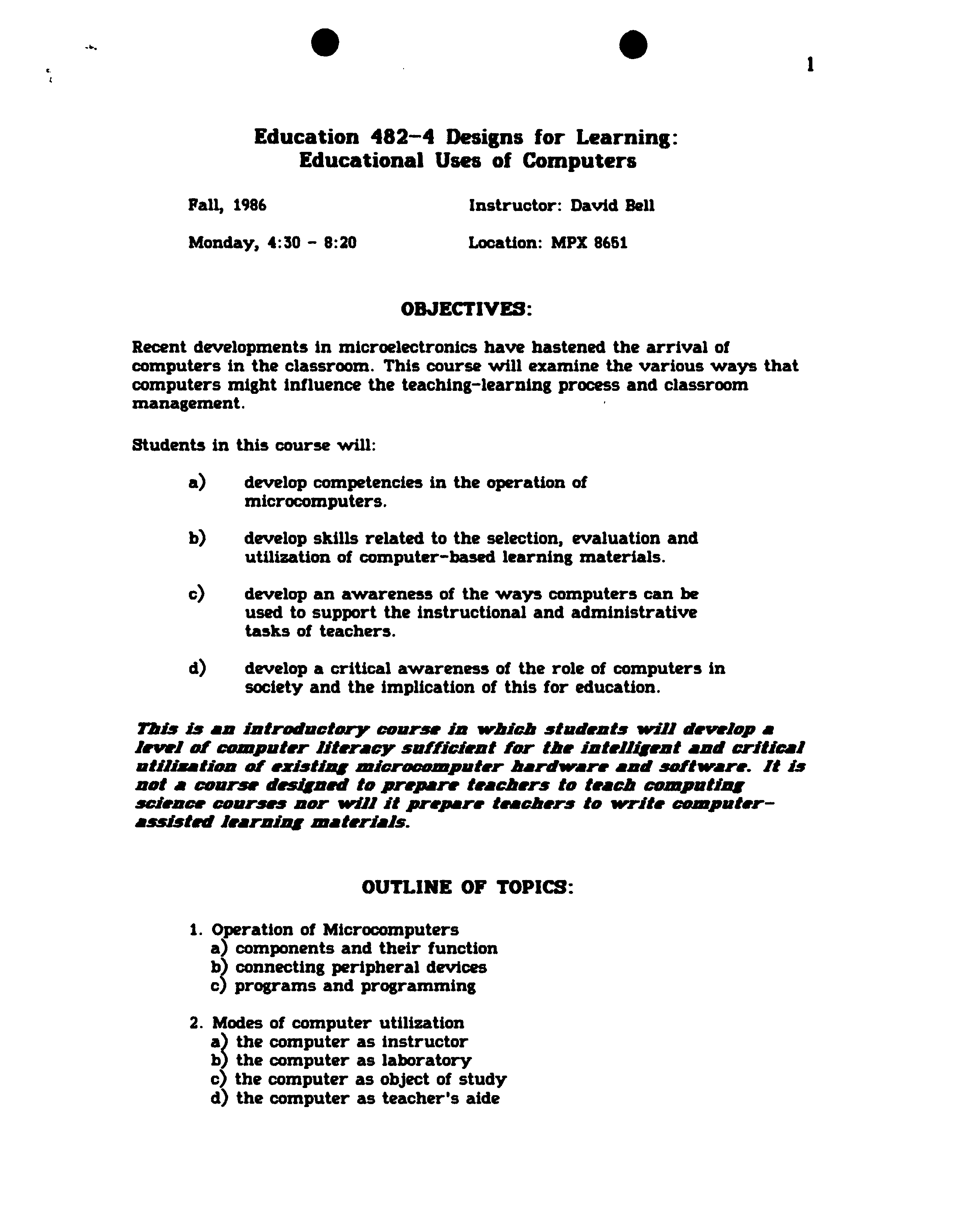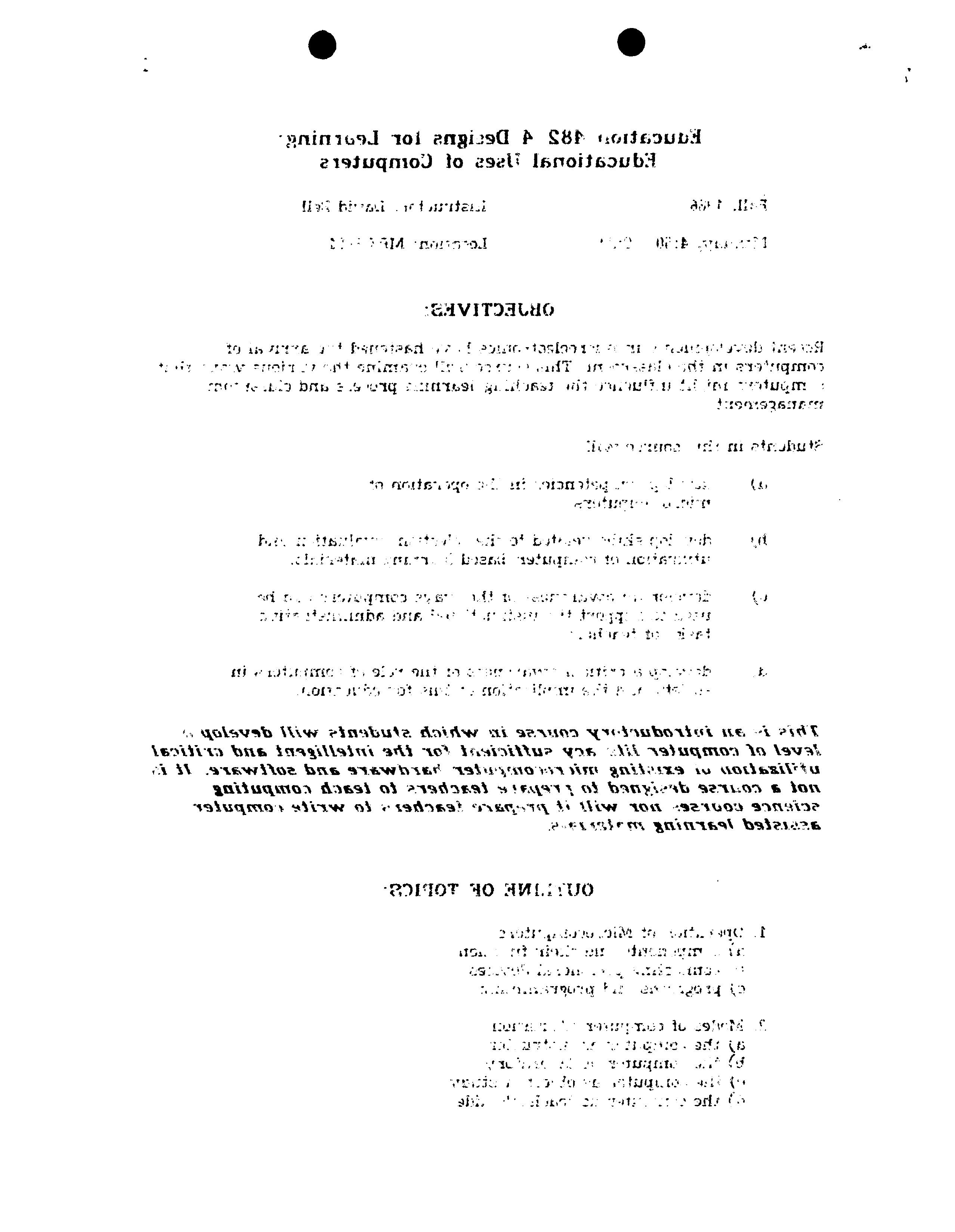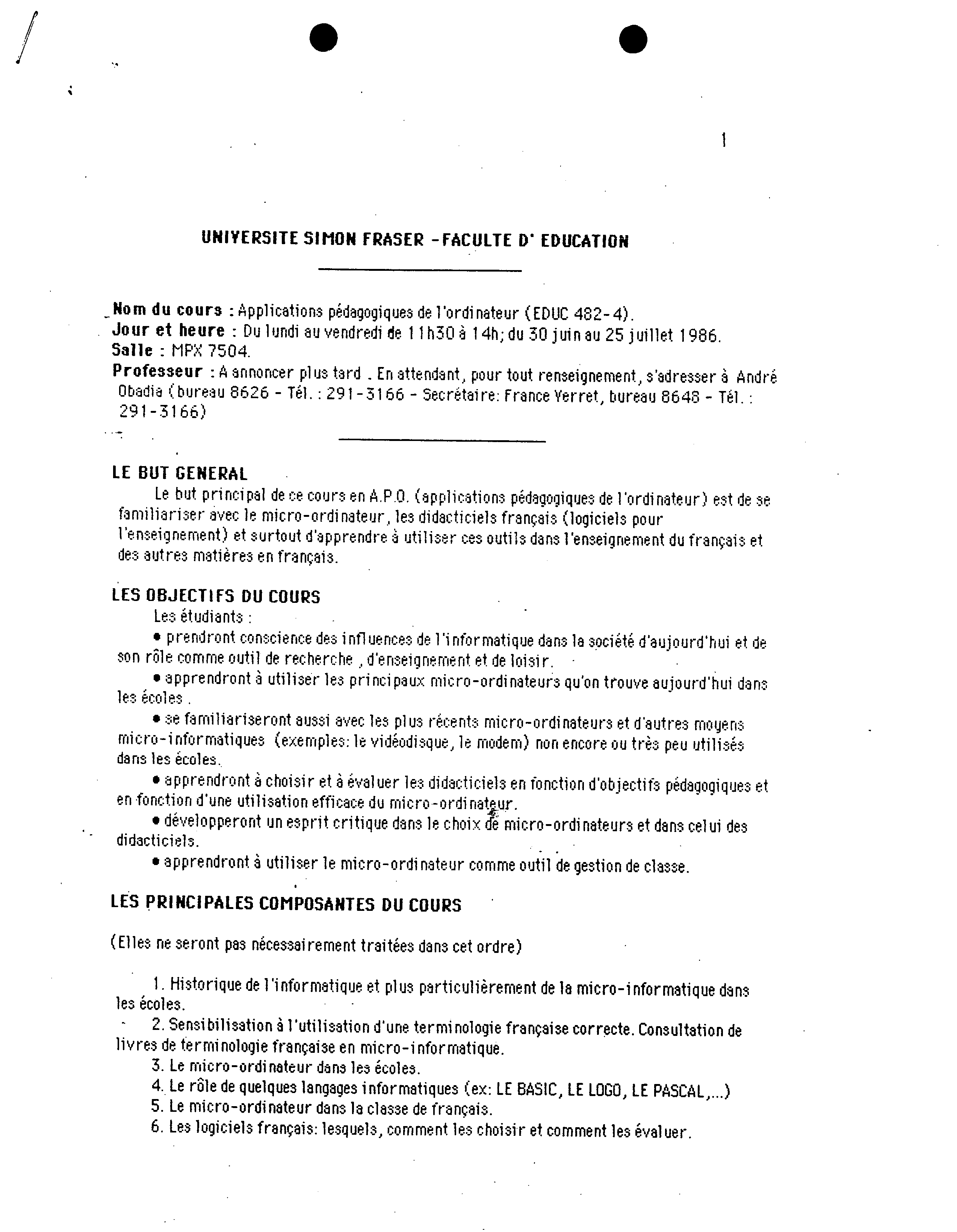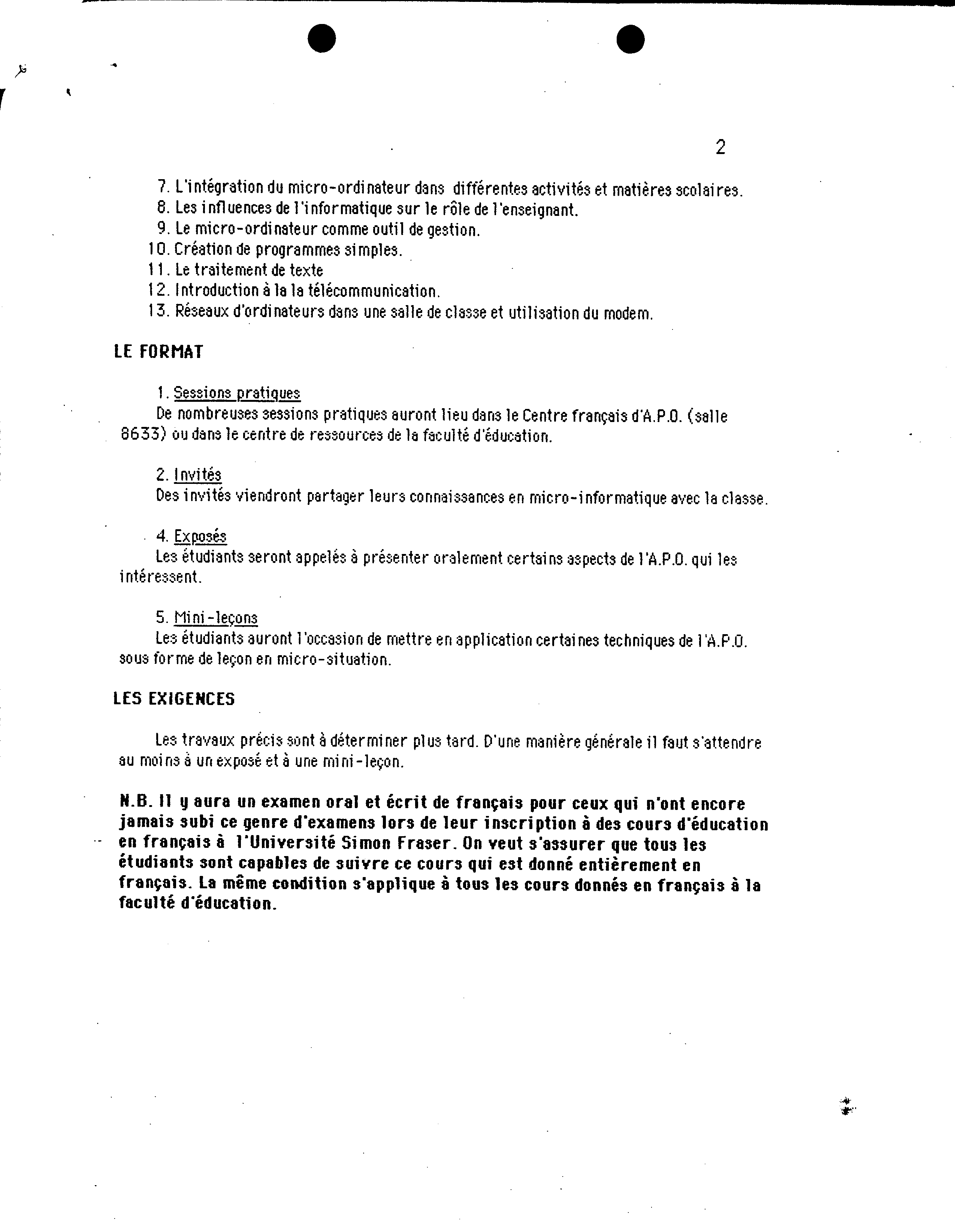. ?
.
Education 482-4 Designs for Learning:
?
Educational Uses of Computers
Pall, 1986
?
Instructor: David Bell
Monday, 4:30 - 8:20 ?
Location: MPX 8651
OBJECTIVES:
Recent developments in microelectronics have hastened the arrival of
computers in the classroom. This course will examine the various ways that
computers might
Influence
the teaching-learning process and classroom
management.
Students in this course will:
a)
develop competencies in the operation of
microcomputers.
b)
develop skills related to the selection, evaluation and
utilization of computer-based
learning
materials.
c)
develop an awareness of the ways computers can be
used to support the
instructional
and administrative
tasks of teachers.
d)
develop a critical awareness of the role of computers in
society and the implication of this for education.
This is an introductory course in which students wili develop a
Jew! of computer literacy sufficient for the inteitgent
and critical
ulihization of existing microcomputer hardware and software. IS is
not a course designed to prepare teachers to teach computing
science courses nor will it prepare teachers to write computer-
assisted learning materials.
OUTLINE OF TOPICS:
1. Operation of Microcomputers
a) components and their
function
b) connecting
peripheral devices
c)
programs and programming
2. Modes of computer utilization
a)
the computer as instructor
b)
the computer as laboratory
c)
the computer as object of study
d) the computer as teacher's aide
.
?
.
rtinm9J 'zot nlai2
q
u
?
81"
fitu1I
19iuqrnoJ to el'; IbpoiJubi
.h'
',Li ?
10
?
Jjj1L.L
J4 ?
? ?
st
ViTD3flO
tO
u,
?
;r
?
ti ?
f ?
•1
?
Lv, ?
:.;
.v ?
r,.'c4 ?
'•itfT ?
ii
?
1
?
c'
'iq
::cit.t
?
. ?
ifJ
.i
?
jt,L1
?
i;
.'J ?
ULfF!
: ?
:1fl ?
(II ?
'.JMJ
•,i
• ?
•
f r
!tJ :
?
i: ?
1
?
• ?
--h:
t
O1
?
flU ?
- ?
- ?
-: -
\\+
? &*1
wiv
?
Vt se
?
vnWi
if-31, \\
?
vicv \c
9•
?
'cwi
\
. ?
c''v ?
\i'+ir ?
ç
r
't-
OrIOT io
q l4L'.; uo
-ir
It..
IL ;. ?
•iu;I1: ?
.,.
?
(t5
j ?
!t ?
c ?
u&n,: ?
'.
.
?
. ?
2
3. Selection and utilization of software
a)
sources of materials
b)
evaluation of courseware
c) integrating computers in the curriculum
4. Computer literacy
a) print and non-print materials on computers
b)
role of computers in schools and society
c)
status of computers in B.C. schools
d) use and misuse of computers in education
COURSE ACTIVITIES:
Course activities will consist of lectures,
demonstrations,
readings and laboratories.
EVALUATION:
Evaluation will be based on:
1.
a paper reviewing the application of computers in a
selected curriculum area (10 pages)
2.
a critical evaluation of a piece of software (software
review) (2-3 pages)
3.
short tests related to the lectures and readings
4.
demonstartlon of computer operating skills
REQUIRED TEXTBOOKS:
Kinzer, Sherwood, Bransford, ComDuter Stratesies for Education: Foundations
& Content - Area A
p flcations. Merrill Publishing.
PREREQUISITES:
?
Education 401/402 or equivalent.
.
?
.
UNIVERSITE SIMON FRASER -FACIJLTE D EDUCATION
Horn du cours
Applications pédagogiques de l'ordinat.eur (EDUC 482-4).
Salle
Jour et
:
MPX
heure
704.
:
Du luridi su vendredi de 11 h30 6 1 4h; du 30 juin au 25 juillet 1986.
Professeur :
A annoricer plus tard En attendant, pour tout renseignement
)
s'edresser a André
Obadia (bureau 8626-T61.:
291-3166 -
Secrétaire: France Verret, bureau 8648-T61.:
291-3166)
IL BUT GENERAL
Le but principal de ?::e co'jrs en A.P.O. (applications pédaao'iques de l'c'rdinateur) est de se
familiariser avec Ic micro-ordinateur, lea didacticiels français (logiciels pour
l'enseignement) et surtout dapprendre utiliser ces outils dens lenseigriement du français
et
des autrea matléres en rrançais.
LES UBJ[CTIFS DU COUPS
Les étudiants
• prendront conscience des influences ic l'iriformat.ique dens Ia société d'aujourdhui et ic
son role comme outil de recherche tleriseiqr,ercierit et de loisi r.
• apprendrontà utiliser les principaux micro-ordinateurs quon trouve auiourdhui dana
lea écoles
• SC
fa ml liariseront aussi
avec
lea plus réu::erits micro-ordi nateurs et dautres moijeris
micro-iriformatiques (exemples: le vidéodisque
1
le modem) non encore ou trés peu utilisés
daris
les écoles.
• apprendront a chosir et i évaluer les didacticiels en fonctiori dobjectifs pédaogiqiies et
en fonction dune ut.ilisat.jon efficace du micro-ordi natur.
• développercirit in esprit critique dens Ic choix dê micro-ordinateure et dens celul des
didacticjel.
• apprendront a utiliser le micro-ordi nateur comme outil de gestion de classe.
LES PRINCI PALES COMPOSAHTES DU COURS
(Ellee ne seront pas nécessairement traitéee dens cet ordre)
1. Historique de 1 informatique et plus psrticuiiérement de is micro- i nformati que dens
lea écoies.
- ?
2. Sensibilisation alutilisation dune terminologie françsisecorrecte. Consultation de
livree de terminoloqie frençaise en micro-informatique.
3.
Le rriicro-ordinoteur dane lee écoiee.
4.
Le rOle de quelques ]engages I nformatiques (ex: LE BASIC, LE LOGO, LE PASCAL,...)
5.
Le micro -ordinate ur dens is classe de francais.
6.
Lee logiciels français:
leaquels
comment lee choisiret comment lea évaiuer.
S
?
S
7.
Lintégration d micro-ordinateur dana différentea activités et rnatières accilaires.
8.
Les influences de Finformatique surle r6le deFenseignant.
9.
Le micro-ordinateur comme outil de geation.
10.
Creation de programmes aimples.
11. Ic traitement de texte
12.
Introduction ala la télécommunication.
13.
Réseaux dordinateurs dana inc sal le de classe et utili:3ation di modem.
LE FORMAT
1.
Sessions prat.iques
Dc nombreusea sessions pratiques auront lieu dana le Centre françaia dA.P.0. (salle
8633) ou dana le centre de reasourcea ije lo faculté dedication.
2.
Invites
Des invites viendront part.aer leurs co n nai ssa nces en mic.ro-informatique avec la classe.
• 4. Exposés
Lea Ctudiants seront appelCs a presenter oralement certains aspects de
?
.P.0. qul lea
I nitCreasent.
5.
Mini-leçons
Lea étudiants auront l'occaaion de mettre en application certai nes techniques de 1 .P.iJ.
SOIJS
forme de leçon en micro-situation.
IfS EXIGENCES
Lea travaux précis a:'nt a determiner plus tard. D'une manlére gCnCrale ii faut sattendre
au mol na a un exposé et a inc ml nil -] ego n.
N.B. Ii ij aura un examen oral et écrit de 1rançais pour ceux qul nont encore
jamais subi ce genre dexamens lors de leur inscription a des cours déducation
en français a FUniversité Simon Fraser. On veut sassurer que tous Iles
étudiants soot capables de
suivre
ce cours qul est donné entièrement en
fronçais. La memo condition sapplique ô to
y
s les cours donnés en français ô la
faculté déducation.
4





